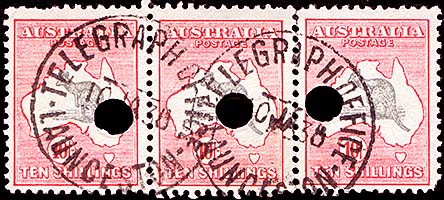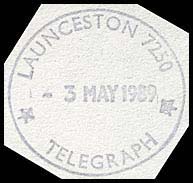Telegraph Offices on the first line.
- Home, index, site details
- Australia 1901-1988
- New South Wales
- Overview of NSW
- Telegraph lines
- Telegraph Offices
- Date stamps
- Forms
- Envelopes
- Rates
- Stamps
- Queensland
- Overview of Qld
- Telegraph lines
- Telegraph offices
- Date stamps
- Forms
- Envelopes
- Rates
- Stamps
- South Australia
- Overview of SA
- Telegraph lines
- Telegraph Offices
- Date stamps
- Forms
- Envelopes
- Rates
- Stamps
- Tasmania
- Overview of Tasmania
- General developments
- Reports
- Organisation
- Telegraph lines
- Telegraph Offices
- Date stamps
- Railway lines
- Forms
- Envelopes
- Rates
- Stamps
- Overview of Tasmania
- Victoria
- Overview of Vic.
- Telegraph lines
- Telegraph offices
- Date stamps
- Forms
- Envelopes
- Rates
- Stamps
- Ephemera
- Western Australia
- Overview of WA
- Telegraph lines
- Telegraph Offices
- Date stamps
- Forms
- Envelopes
- Rates
- Stamps
|
The telegraph wires were extended to Bothwell in January 1870 while a Telegraph Office opened in 1871 at the Post Office with Sarah Robinson as the Operator. The Post Office had opened in 1832. Bothwell is the home of Ratho - the oldest golf course in Australia. It was built in the 1850s - before the telegraph was connected! It is also now the home for Nant distilleries. The earliest recorded telegram to Bothwell is 31 August 1871 from Green Ponds. |
||
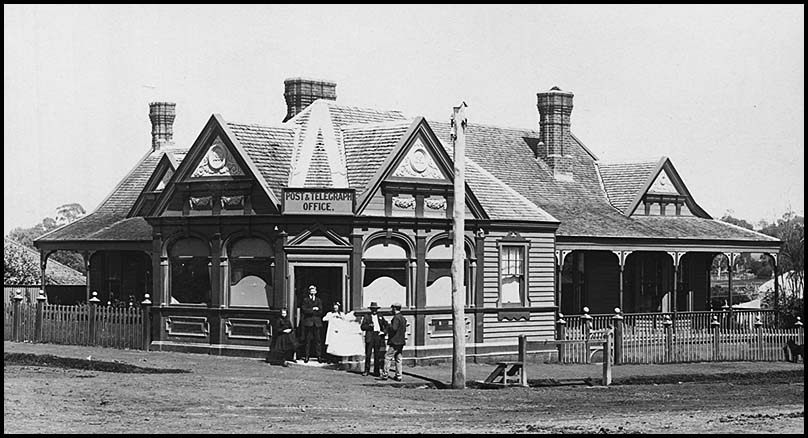 Bothwell Post & Telegraph Office - as confirmed by the sign above the door. This building was constructed about 1890. |
||
 Bothwell Post Office - after recent renovations. |
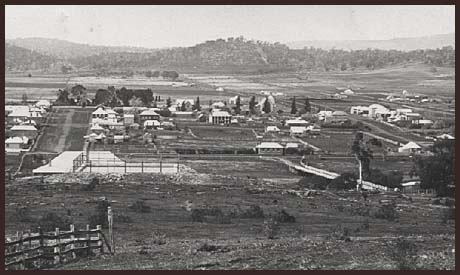 Bothwell and the surrounding region about 1910. |
|
| In the post-1902 period, the usual postal cancellations were used at Bothwell. No special date stamp was issued to Bothwell for use with telegrams.
The type 2C steel date stamp:
|
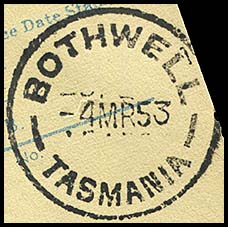 4 March 1953. Used on AW-DO-10 (1950). |
|
During a visit to New York in 1854, John Young wrote to his friend and neighbour at Bothwell as follows:
|
||
| George Town.
In 1871, had offices at Low Head (2 staff) and Nine Mile Springs (operator A.T. Morrison). A telegraph office was opened to the public in 1873.
|
||
|
The telegraph wires were extended to Green Ponds in January 1870. The Telegraph Office may have been opened later in the year at a location separate from the Post Office. The earliest recorded telegram from Green Ponds is 18 May 1871 to Launceston. There is however a hand written summary on the reverse of a Cable transmission form showing 3 messages had been sent during the week ending 13 August 1870 and 4 messages in the following week. Green Ponds was used as a telegraph station for surrounding towns which did not have telegraph facilities at the time. An example of a message written on an envelope as a transmission form and sent from Bothwell to Green Ponds in 1875 for onward transmission is shown elsewhere. In September 1881, discussions were held to merge the Post and Telegraph Offices into a new office within the context of merging all the public offices (Municipal, Police, Library, lecture theatre, etc) into the same premises. The town was renamed Kempton in 1838 although the Post Office did not change its name to Kempton until 18 March 1895. |
||
No date stamp was issued to Green Ponds for use with telegraphs. Postal date stamps were used. |
Used on TC-DO-3A. |
|
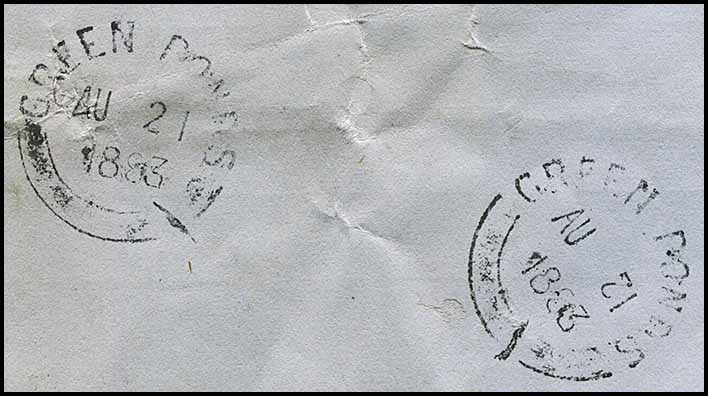 Two Green Ponds date stamps for 21 August 1883 on the reverse side of a TC-TO-3E transmission form. The day wheels for the right strike had been set in reverse but this was corrected for the left strike. Only recorded example. |
||
| Plain cover sent from Hobart to Mr. Allison of the Telegraph Office in Launceston on 18 April 1895. |  Provenance: Clemente (Spink Sale September 2016, Lot 269). |
Rubber oval date stamps - TELEGRAPH OFFICE/ LAUNCESTON. |
|||
|
 12 September 1887. Used on TC-DO-4A. |
||
|
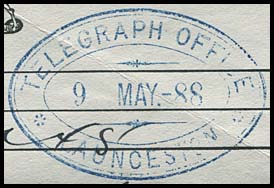 9 May 1888. Used on TC-DO-4A. |
 8 September 1889. Used on TC-DO-4B. |
|
|
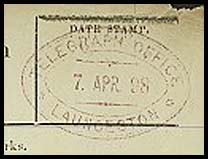 7 April 1898. Prestige Aug 2005 Lot 411. |
||
| Rectangular rubber date stamps with LAUNCESTON. | |
Circular steel date stamps with Launceston/ Tasmania. |
Two line date. Two digit year. Dots for separation are towards the base of the letters. No code letter under Launceston. Diameter: 23 mm. |
|
Used on TI-MO-3. |
|
Two line date. Two digit year. Has circle stops for separation. No code letter under LAUNCESTON. Diameter: 24 mm. Used from 28 January 1899 (TC-DO-5A) to 10 March 1904. |
Used on TC-DO-5A. |
Used on TI-RO-2. |
|
Two line date. Two digit year. Has cross stops for separation. No code letter under LAUNCESTON. Diameter: 25 mm. |
|
||
Two line date. Two digit year. Has no stops for separation. No code letter under LAUNCESTON. Diameter: 23 mm. Clemente had reported that this date stamp had never been seen on a telegram form. |
Used on TC-DO-5A. |
Used on TI-DO-6. |
|
RC3 Launceston.
Has small stars at the center of the letters between top and bottom words. Type 2a (1v) rubber date stamp. Diameter: 32 mm. Rated RRR. |
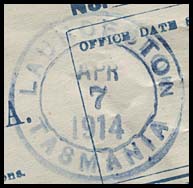 7 April 1914. |
|
|
Has small stars at the center of the letters between the top and bottom words. Type 2a (1v) rubber date stamp. Diameter: 28 mm. Rated RRR. |
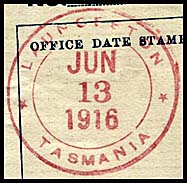 13 June 1916. Used in red. On TI-DO-3C. |
On Reply Paid form TI-DR-1. |
On AE-DO-1. |
RC6 Launceston. Has large stars at the bottom of the letters between the top and bottom words. Type 2a (1v) rubber date stamp. Diameter: 37 mm. Rated RRR. |
 15 Jan 1920 Rubber.jpg) 15 January 1920. Used in blue. |
| Rubber rectangular handstamp.
Launceston (RRH-1). Size: 26 × 58 mm. Has a consecutive counter number to the right of the date. |
 28 September 1894. Used on TC-DO-4B. |
| Telegraph Office/ Launceston.
Used: 12 January 1927 to 20 August 1954. Diameter: 29 mm. Rated: R. |
|
||
 Telegraph Office, Launceston. 3 November 1938. Used on a pair of grey £1 Kangaroo on Map. Mossgreen, March 2015 Lot 2074. |
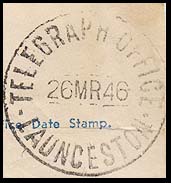 Telegraph Office, Launceston. 20 March 1946. LAUNCESTON at base. |
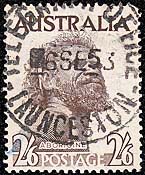 Telegraph Office, Launceston. 6 September 1953. |
|
| Launceston/ Telegraph. Rubber circular date stamps. Diameter: 31 mm. Archival strikes of a datestamp not recorded used on a telegram. Al have the same date stamp date of 3 May 1989 which is beyond the date of availability of telegrams. The first format has two stars while the second has one star and a Crown. |
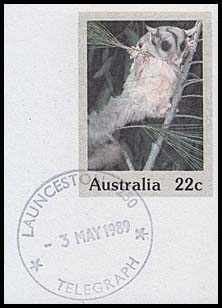 |
 Launceston TELEGRAPH. 3 May 1989. |
|
||
| All Launceston Slogan date stamps. | 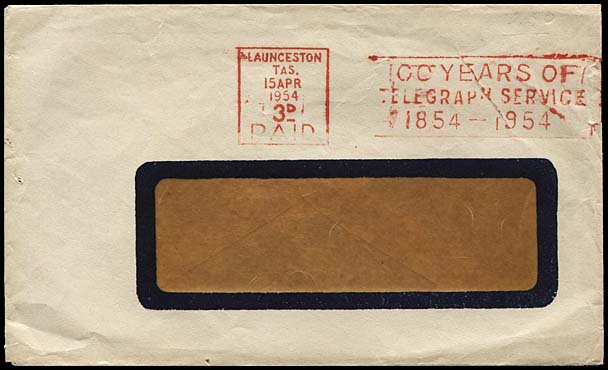 |
|
Launceston Rail.
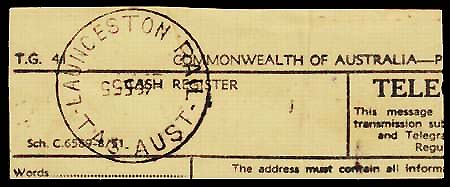 Source: Torsten Weller 2012. |
|||
Longford.
The Electric Telegraph office was opened separate from the Post Office. The first Operator was W. Mason jnr. |
The Electric Telegraph Office was established in 1871 separately from the Post Office. The Operator was J. Ryan Jnr. The Post Office main routecConnected to Tunbridge, Anthill Ponds, Jericho, Spring Hill and Tunnack. |
 Oatlands. 15 March 1897. No separating marks between Used on TC-DO-5A. |
||
|
The Telegraph Office was established by 1865. It was separate from the (Money Order) Post Office. The Operator was Miss Hall. Unfortunately the North West Post of 1 August 1905 announced that "Salary for the three months during the period of her suspension from duty is allowed to Miss Elizabeth Hall late Postmistress at Ross whose resignation from the Public Service was enforced". |
||
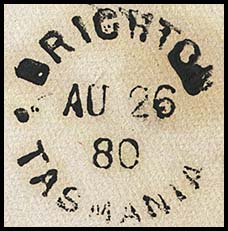
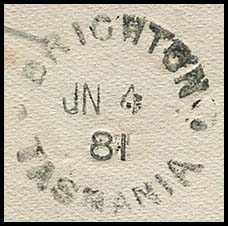


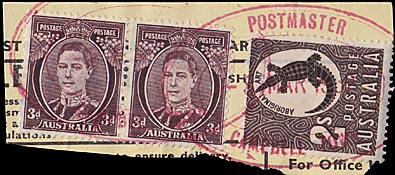
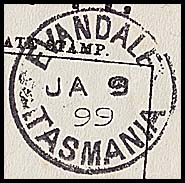
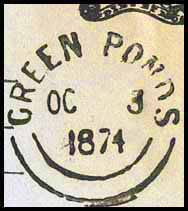


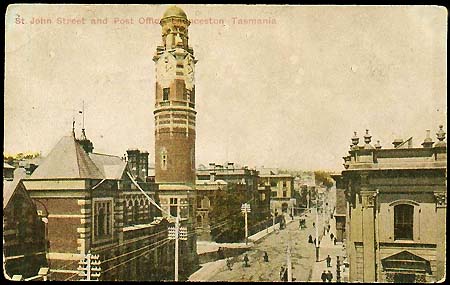

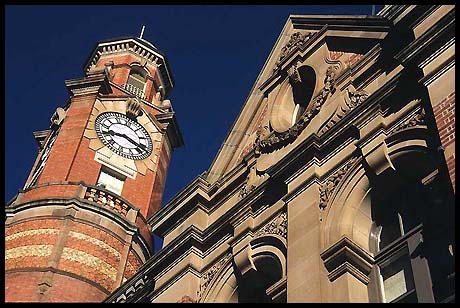
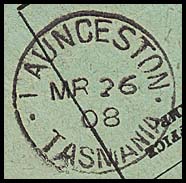

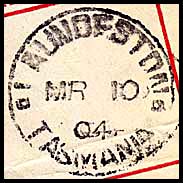


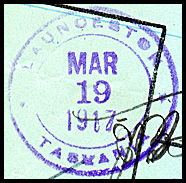
 12 May 1919 Rubber.jpg)
